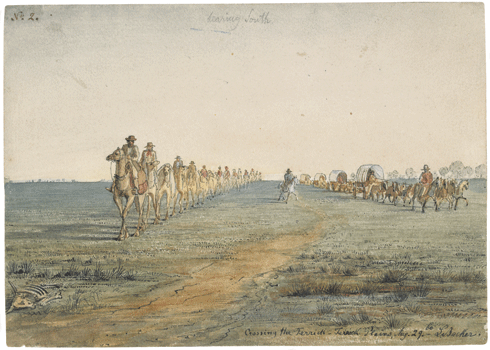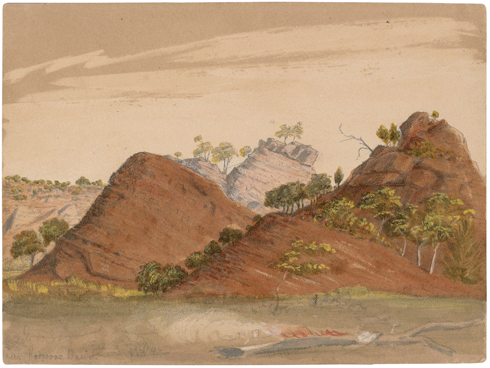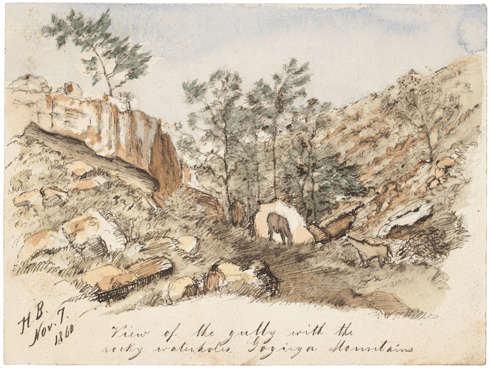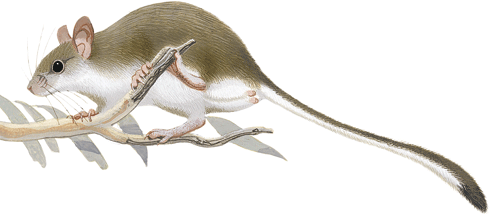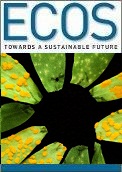
|
Published: 5 December 2011
The Burke and Wills expedition – a valuable scientific legacy revealed
Researchers looking into the remaining dispersed – and largely overlooked – records of Burke and Wills’ expedition have discovered fascinating and meticulously collected scientific data. The records provide a valuable baseline perspective on Australia’s environment 150 years ago, and shed new light on the remarkable achievements of the explorers under extreme conditions.
When Robert Burke led the Victorian Exploring Expedition out from Melbourne’s Royal Park on 20 August 1860, the organisers – the Royal Society of Victoria – anticipated that it would result in a huge increase in knowledge of a large area of Australia’s unknown interior.
Leaving from the settled districts of Victoria, the explorers were instructed to enter terra incognita proper, beyond Menindee on the Darling River in south-western New South Wales. If possible, they were to continue in a more-or-less direct line across the continent, from south to north. They were to set up a depot in the arid centre at Cooper Creek, from which a northern party could then attempt to reach the Gulf of Carpentaria.
Three scientists were attached to the expedition: William Wills, as navigator and astronomical observer; Ludwig Becker, as scientific illustrator, zoologist and geologist; and Hermann Beckler, as botanist. Physicist George Neumayer accompanied the expedition on part of the journey, from Swan Hill to the Darling River, making magnetic, meteorological and astronomical observations.
Once the party left Melbourne, the general public viewed the expedition more as a bold adventure and a race to the north coast against the rival colony of South Australia. But for the organisers, such as botanist-explorer Ferdinand Mueller, the pursuit of ‘geographical science’ – including documenting the landscape and returning natural history specimens – was the highest priority.
This was well expressed in 1860, by the Governor of Victoria and President of the Royal Society, Sir Henry Barkly:
“a clearer insight into the nature and extent of the central desert cannot fail to elucidate phenomena not now easily explicable, and to complete our stores of information as to the Meteorology and Mineralogy, the Fauna and the Flora, of this most exceptional and extraordinary portion of the Globe.” |

|
|
‘“Mallee Sand-cliffs” at the Darling’ (Figure 3.5). Ludwig Becker. 12 October 1860. State Library of Victoria Australian Manuscripts Collection. Accession no. H16486. Credit:
CSIRO Publishing
|
However, the tragic ending to the expedition meant that public attention focused on the ‘deplorable sufferings’ and ‘melancholy fate’ of the explorers. Perhaps under a perception of failure, the team’s scientific results were, it seems, overlooked. Although it was intended that the results be published – as was usual with exploring expeditions – no official history was ever attempted.
Most of the expedition’s scientific data and specimens remained dispersed in various notebooks and drawers, unanalysed and largely unknown. As a result, it has generally been assumed that the explorers achieved little of scientific value. A new book, ‘Burke and Wills: The scientific legacy of the Victorian Exploring Expedition’, changes all that.
Finding fine perspective in the data
In gathering and delving into the Burke and Wills expedition’s surviving records, the book’s authors found to their surprise that the scientists of the main expedition – as well as those of ensuing relief expeditions – carried out a great deal of novel and valuable scientific work.
Some of the diaries and specimens have been lost, and in many respects, the original and remaining scientific material is limited. But overall, a far more substantial body of information and artefacts survived than anyone had previously suspected.
Observations made all the way from Victoria to the Gulf of Carpentaria, in disciplines such as geology, botany, zoology, hydrology, meteorology and anthropology, provide us with valuable baseline data on key aspects of the Australian environment.
Wills wrote three survey reports from Balranald to Cooper Creek, and kept a regular diary for the whole trip. Although north of Cooper Creek his record becomes somewhat less detailed, it still contains much original, historically significant information.
As noted by Elizabeth Ninnis in Appendix E, Becker’s scientific illustrations and notes, and Beckler’s narrative and pictures, are another rich source of information on the environment. In addition, all three men sketched maps of the terrain, noting the presence of landforms and watercourses. Frank Leahy points out in Chapter 2 that contrary to previous opinion, Wills was extremely accurate in his navigating and astronomical observations.
Additional information resulting from Wright’s supply party, Brahe’s depot party and the various relief parties all give us a first glimpse of the kind of environments the explorers encountered. Howitt’s relief party returned with a number of artefacts including zoological specimens. All parties provided information on a wide variety of habitats, including semi-arid, arid, sub-tropical, tropical and temperate environments, and they passed through country that was remarkably rich in biodiversity. They witnessed the early changes that already had taken place in the newly settled areas – the effects just becoming evident at the ‘invasion frontier’, especially just north of the Darling River – and they also entered truly pristine country (for Europeans).
In the drier interior, the parties gained the first information on desert Aboriginal peoples, and found, unexpectedly, relatively large communities living in such harsh environments.
An environmental and terrestrial snapshot
Bernie Joyce and I disclose in Chapter 3 that as the expedition party crossed the flat Terrick Terrick plains in northern Victoria, Becker noted that the water in the Piccaninni Creek (a continuation of Bendigo Creek) was discoloured by yellow floating mud from the gold diggings at Bendigo – an early sign of concentrated human activity affecting the natural environment.
Beckler, meanwhile, gives detailed descriptions of many aspects of the environment throughout his writing. For example, when they are in the riverine regions of the Murray River, he comments that the area gives one ‘the impression of a landscape filled with exuberant life’.
In contrast, further north, when passing through the semi-arid mallee country, the physicist George Neumayer comments that apart from some birds, ‘we have not seen any animals during the whole trip from Lake Paika to the Darling’.
In Chapter 6, Charles Lawrence says that the expedition gained a useful picture of surface water and groundwater location and drainage patterns, as well as surface geology.
Flora and fauna discoveries
In Chapter 4, Linden Gillbank reviews the activities of the expedition’s botanist, Hermann Beckler. He collected more than 900 plant specimens, which are now housed at the National Herbarium of Victoria1. Beckler’s expedition collection is important, because of its substantial size and geographic and taxonomic range. His specimens were used to name dozens of new species and varieties.
Sadly, some of the plants collected by Beckler are now endangered or extinct: for example, the spiny everlasting daisy that Mueller named Acanthocladium dockeri. Intriguingly, a few of Beckler’s specimens appear to be non-indigenous introduced species.
Beckler’s herbarium records can be used to generate plant species lists for his collecting localities in western NSW, in places such as Mutawintji, Mount Koonenberry and Torowoto Swamp that were near – or perhaps ahead of – the European invasion frontier. Beckler’s data reveals some of the plants that flourished before the destructive incursion of European-introduced animals. Beckler’s and Becker’s landscape sketches and paintings can also provide such insights.
Chapter 6 (zoology) was edited by Bernie Mace, who also wrote the introduction and sections on reptiles and fish. Four other authors also contributed sections: Peter Menkhorst on mammals, Rory O’Brien and Craig Robertson on birds, and Alan Yen on invertebrates.
Although the only surviving zoological specimens associated with the Burke and Wills expedition are in a small collection brought back by Alfred Howitt, they are useful, because they fill in some gaps in the record.
Peter Menkhorst reveals that the Howitt animal collection includes two extinct species of rodents. One of these is the intriguing white-footed rabbit rat, Conilurus albipes, which now seems to have been formerly widespread across the temperate regions of south-eastern Australia, but became extinct fairly rapidly following settlement. Until the expedition records were looked into, this species was not suspected to have lived quite as far inland as the Bulloo River/Cooper Creek region where it was seemingly reported by Beckler and collected by Howitt’s party. Menkhorst emphasises that:
“The white-footed rabbit rat then vanished completely, and with remarkable suddenness. It was one of the very first of a wave of mammal extinctions that swept across inland Australia during the second half of the nineteenth century, and early decades of the twentieth century, eventually claiming 21 species (including 10 species of rodent), a mammalian extinction event unmatched in recorded history.” |
As Rory O’Brien and Craig Robertson show, there are numerous references to birds in the records, and a partial but not insignificant picture can be gained of their former abundance and distribution. Unlike the mammals, the bird species recorded are very much the same as exist today, although the authors say we may conclude from the sources that some birds were more numerous than they are today (e.g. some ground dwelling birds), and others may show the reverse trend (e.g. crested pigeon, galah and little corella). There is also reference to a possible first sighting of the gibberbird, Ashbyia lovensis, by Wright as ‘a small bird not unlike a mule canary’.
The section on reptiles by Bernie Mace reinforces that Australia’s arid zone has a greater diversity of reptiles than similar areas on other continents. Becker’s detailed portrayal of 10 undescribed species, and descriptions of three others, represented a major advance in knowledge of the reptile fauna of Australia’s arid heart.
Similar comments could be made for the two fish species depicted by Becker, and Howitt’s specimen of Welch’s Grunter. As Alan Yen comments, the focus on invertebrates from a scientific viewpoint was minimal, but some meaningful identifications were made.
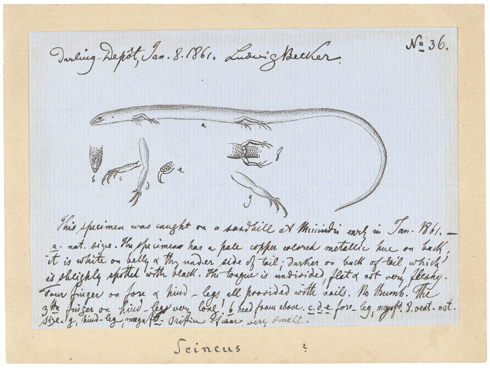
|
|
‘Scincus’ (Figure 5.11). Ludwig Becker. 8 January 1861. State Library of Victoria Australian Manuscripts Collection. Accession no. H16486. Lerista aericeps. Credit:
CSIRO Publishing
|
A remarkable historical record
One of the real surprises of the review was the expedition’s meteorological records, analysed by John Bye in Chapter 7. He says the scientists and assistants at Menindee and Cooper Creek kept meticulously recorded and fairly complete meteorological records which can be used to compare coastal and inland areas. Combined with other information, such as the presence of a plague of the native long-haired rat (Rattus villosissimus), the meteorological data help us reconstruct a more complete picture of the environment, and to make comparisons to today’s conditions in which similar ecological, geographical and climatic conditions have prevailed.
Finally, in Chapter 8, Harry Allen draws attention to the native Aboriginal communities’ ability to survive in severe environments. He also describes the contribution of Aboriginal knowledge and technology to the explorers’ initial survival, and also of their subsequent failure to fully understand its significance: e.g. in the preparation of the native food ‘nardoo’, which was probably an important factor leading to the explorers’ ultimate death. Perhaps there are lessons still to be learned from these records on how to live sustainably in these areas today.
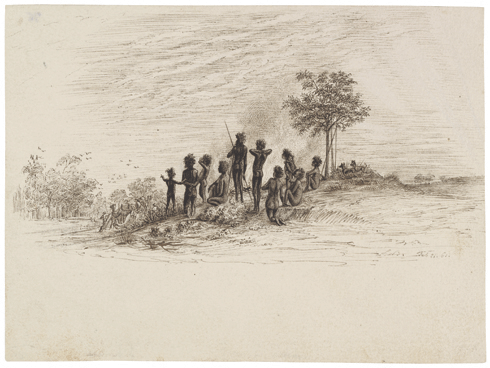
|
|
‘Arrival of the party at Duroadoo’ (Torowoto) (Figure 8.3). Ludwig Becker. 21 February 1861. State Library of Victoria Australian Manuscripts Collection. Accession no. H16486. Credit:
CSIRO Publishing
|
Additional research on the records of the Burke and Wills expedition, and of the associated relief expeditions, is certain to help further fill the gaps in the scientific record. But, a great leap forward has already been made by the authors of the present book.
Perhaps more poignantly, as we mark 150 years since the expedition came to be seen as a tragedy, this detailed review of its data belatedly recognises that the explorers achieved a remarkable and valuable record of inland Australia that serves us today.
Linden Gillbank, Bernie Joyce, Bernie Mace and Douglas McCann, all authors of the book, contributed to this article.
More information
Burke and Wills, The Scientific Legacy of the Victorian Exploring Expedition, edited by EB Joyce and DA McCann (2011) is published by CSIRO Publishing.
1 The assistance of staff at the National Herbarium of Victoria (MEL), Royal Botanic Gardens Melbourne, was essential for the preparation of Chapter 4.


